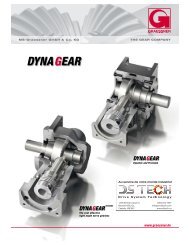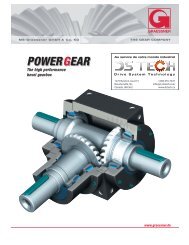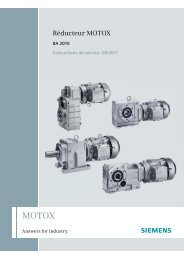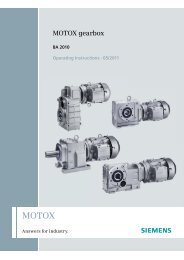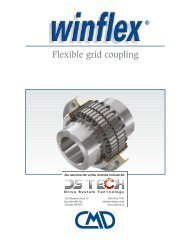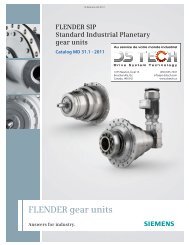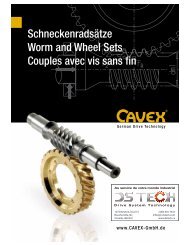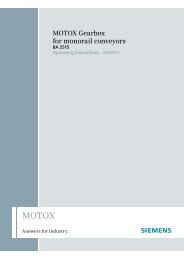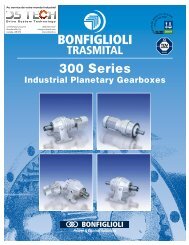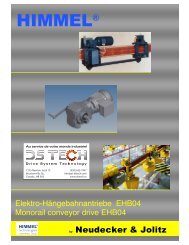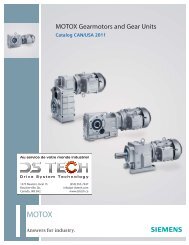FLENDER Standard Couplings - DS TECH
FLENDER Standard Couplings - DS TECH
FLENDER Standard Couplings - DS TECH
- No tags were found...
You also want an ePaper? Increase the reach of your titles
YUMPU automatically turns print PDFs into web optimized ePapers that Google loves.
<strong>FLENDER</strong> <strong>Standard</strong> <strong>Couplings</strong><br />
Highly Flexible <strong>Couplings</strong> — ELPEX-S Series<br />
General information<br />
© Siemens AG 2011<br />
Further application-related coupling types are available.<br />
Dimension sheets for and information on these are available on<br />
request.<br />
Fail-safe device of ELPEX-S coupling<br />
The following versions have already been implemented a number<br />
of times:<br />
• ELPEX-S coupling with brake drum, brake disk or flywheel<br />
mass<br />
• ELPEX-S coupling with axial backlash limiter<br />
• ELPEX-S coupling with adapter<br />
• ELPEX-S coupling with bearing for mounting a cardan shaft<br />
• ELPEX-S coupling for engaging/disengaging during standstill<br />
• ELPEX-S coupling as part of a coupling combination<br />
• ELPEX-S coupling with fail-safe device<br />
G_MD10_XX_00023<br />
The ELPEX-S coupling can also be designed with a fail-safe device.<br />
If the rubber disk element fails, the coupling can continue<br />
operating in emergency mode for a short time. This option is frequently<br />
required e.g. in the case of marine drives.<br />
(450) 655-7447<br />
info@pt-dstech.com<br />
www.dstech.ca<br />
If the rubber disk element fails, cams transmit the torque from the<br />
inner and outer parts of the fail-safe device.<br />
In normal operation the torsion angle of the rubber disk element<br />
is smaller than the gap between the cams, so there is no metalmetal<br />
contact.<br />
■ Function<br />
The ELPEX-S coupling's transmission characteristic is determined<br />
essentially by the rubber disk element. The torque is<br />
transmitted positively between the rubber disk element and the<br />
outer flange. The outer flange can be bolted to e.g. a diesel motor<br />
or compressor flywheel.<br />
■ Configuration<br />
Coupling selection<br />
Coupling load in continuous operation<br />
11<br />
The ELPEX-S coupling is especially suitable for rough operating<br />
environments. An application factor lower than that in<br />
catalog section 3 is therefore sufficient for all applications.<br />
In the case of machines which excite torsional vibration,<br />
Siemens urgently recommends carrying out a torsional vibration<br />
calculation or measuring the coupling load occurring<br />
in the drive.<br />
Application factor FB<br />
Torque characteristic<br />
of the driving machine<br />
Electric motors,<br />
hydraulic motors,<br />
gas and water turbines<br />
Internal combustion<br />
engines<br />
Torque characteristic of the driven machine<br />
uniform with non uniform very rough<br />
moderate shock<br />
loads<br />
1.0 1.3 1.4<br />
1.3 1.4 1.6<br />
Examples of torque characteristic in driven machines:<br />
• uniform with moderate shock loads: generators, fans, blowers<br />
• non uniform: reciprocating compressors, mixers,<br />
conveyor systems<br />
•very rough:crushers, excavators, presses, mills<br />
1275 Newton, local 15<br />
Boucherville, Qc,<br />
Canada, J4B 5H2<br />
Temperature factor FT<br />
Coupling Rubber<br />
version<br />
Elastomer<br />
material<br />
NR = natural-synthetic rubber mixture<br />
VMQ = silicone rubber<br />
Temperature T a on the coupling<br />
-40<br />
to<br />
-30 °C<br />
-30<br />
to<br />
+50 °C<br />
to<br />
60 °C<br />
to<br />
70 °C<br />
to<br />
80 °C<br />
to<br />
90 °C<br />
to<br />
100 °C<br />
to<br />
110 °C<br />
ELPEX-S SN, NN, WN NR 1.1 1.0 1.25 1.40 1.60<br />
ELPEX-S NX VMQ 1.1 1.0 1.0 1.0 1.0 1.1 1.25 1.4 1.6<br />
to<br />
120 °C<br />
Select coupling size with: T KN ≥ T N ⋅ FB ⋅ FT<br />
11/4 Siemens MD 10.1 · 2011



